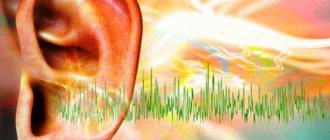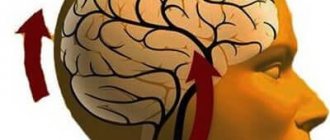VSD of the mixed type has common features with some autonomic dysfunctions, such as orthostatic hypotension and postural orthostatic tachycardia syndrome. These features include orthostatic intolerance and vasovagal syncope. Vegetative-vascular dystonia also has overlaps with other medical diagnoses, including post-traumatic stress disorder, generalized anxiety disorder, major depressive disorder and somatoform disorder.
VSD of mixed type
Vegetovascular dystonia of the mixed type in the strict sense of this definition is not a disease. It is a collective term that summarizes a number of different symptoms (syndromes) associated with dysfunction of the autonomic nervous system. Symptoms include nervousness, sleep disturbances, seizures and cardiovascular problems.
The name “dystonia” comes from the Greek word “tonos” - tension (dis- + tension). Autonomic dystonia literally means “dysregulated tension (dystonus) of the autonomic nervous system” - a violation of the interaction between the sympathetic and parasympathetic departments. This, in turn, leads to physical complaints not related to organic causes.
The autonomic nervous system (autonomic nervous system), part of the peripheral nervous system, supports physiological functions associated with the cardiovascular, respiratory and gastrointestinal systems, but is also closely connected with higher brain systems involved in the emotional and psychological aspects of human life. In the mature brain, it maintains a background level of functioning by communicating with the limbic structures of the brain, which are involved in regulating mood, memories and emotional state.
It includes all areas involved in the control of "autonomic", unconscious and involuntary functions in the context of overall body homeostasis:
- blood pressure;
- heartbeat;
- breath;
- activation of sweat glands;
- extracellular fluid volume composition;
- blood flow;
- metabolic rate;
- digestion;
- kidney function;
- muscle tone of internal organs and so on.
When a person perceives consciously (for example, decides to move), the somatic nervous system is activated. Most of the time, both systems work closely together.
The autonomic nervous system is divided into two functional antagonists:
- Sympathetic department.
- Parasympathetic department.
While the sympathetic system speeds up the heart rate and breathing and primes the entire body for the fight-or-flight response, the parasympathetic system is primarily responsible for the processes of relaxation and regeneration. If the interaction between the sympathetic and parasympathetic nerves does not work properly, symptoms may be classified as autonomic dystonia.
Patients' complaints are based on whether tension has shifted in favor of the sympathetic or parasympathetic: therefore, people with increased sympathetic activity (sympathetotonia) are prone to nervousness, palpitations, high blood pressure and diarrhea. If, on the other hand, the parasympathetic (vagotonia) is dominant, it may be associated with low blood pressure, cold hands and feet, lethargy and constipation.
Helpful information
However, vegetative-vascular dystonia as a diagnosis is controversial, given that various symptoms can be generalized under this term.
Despite the fact that there is no single classification, doctors divide vegetative-vascular dystonia into types, depending on the disorders of the cardiovascular system: hypertensive, hypotensive, normotensive and mixed type VSD, which includes symptoms characteristic of any of the types.
Development mechanism
Metabolic reactions in the human body are regulated by the sympathetic and parasympathetic divisions of the ANS. The first is responsible for activating the work of each body system, and the second is for the accumulation of energy and its further use.
Mixed type vegetative-vascular dystonia is accompanied by an imbalance between these structures, which leads to excessive stimulation or inhibition of the functions of internal organs. Because of this, the classic symptoms of VSD progress.
The exact causes of the pathology have not yet been established. Risk factors for developing dystonia:
- genetic predisposition;
- trauma with damage to the brain and ANS;
- chronic stress;
- mental lability;
- diseases of the central nervous system (meningitis, encephalitis);
- hormonal changes in the body (puberty, pregnancy, menopause);
- presence of bad habits;
- sedentary lifestyle, unhealthy diet;
- endocrine pathology.
Causes
In most cases, vegetative-vascular dystonia does not have a clear cause and occurs as a result of the interaction of various factors. If, after all the necessary medical examinations, a purely physical cause for the symptoms concerned can be ruled out, psychosomatic causes must be considered. Often, excessive psychological stress, in addition to other factors (overstimulation, unfavorable diet, environmental stress, toxins, genetic, hormonal factors), plays a significant role. VSD of the mixed type can sometimes cause frightening conditions (tachycardia) and remain a heavy burden in the long term. Therefore, somatoform disorders are just as serious as those that have physical causes.
Often there is an individual predisposition (genetic predisposition) to the development of one or another form of autonomic disorder. There is a known predisposition to the development of migraine-type headaches to other forms of autonomic disorder, in which a certain organ area is particularly affected, such as the gastrointestinal tract, or colon or other organ system. Thus, an individual threshold value can be reached or, in a particular case, exceeded by the interaction of various factors, and then decompensation, and, thus, the occurrence of an individual symptom complex can be explained as a consequence of mixed type VSD.
Why is diagnosis prescribed for VSD?
Study of laboratory parameters of general and biochemical analysis of blood and urine. It is imperative to examine the content of cholesterol and lipoproteins in VSD of the mixed type.
It is necessary to examine the blood for the presence of bacteria and viruses, as well as antibodies to them. To exclude possible infection by pathogenic microorganisms.
Determine the levels of hormones in the body, and evaluate the functioning of the endocrine and exocrine glands.
Taking indicators of the stomach contents to determine pathogenic microflora, as well as the level of secretion of protective factors and gastric acid.
- What is the diagnosis?
- Daily monitoring of blood pressure and pulse rate;
- Taking an electrocardiogram. It is advisable to carry out this procedure daily throughout the entire diagnostic period;
- X-ray examinations and ultrasound diagnostics;
- Carrying out endoscopic research methods.
If VSD is suspected of a mixed type, it is necessary to conduct a full range of studies of masked serious pathologies.
Main symptoms
VSD represents a theory that explains the occurrence of an individual symptom complex, and on the basis of which the relationship between individual conditions can be understood and explained. Therefore, we can also say that the term mixed type VSD is a medical concept with which certain clinical manifestations can be explained.
Various physical symptoms may occur with VSD:
- general malaise with nausea and vomiting;
- blood pressure surges;
- dizziness;
- headache;
- nervous tremor;
- increase or decrease in heart rate;
- dyspnea;
- increased sweating;
- muscle spasms (calf muscle cramps, toe cramps, muscle tremors, muscle twitching);
- heart problems (irregular heartbeat, heart spasms, heart pain, chest tightness);
- cold hands (caused by spasms of blood vessels);
- nervousness, anxiety, irritability;
- insomnia;
- loss of sexual desire and other symptoms.
VSD symptom complexes of mixed type often occur together and are sometimes considered as independent diseases with an unknown cause. One example is hyperkinetic cardiac syndrome, which is associated with rapid heartbeat and large fluctuations in blood pressure.
Symptoms
Mixed type dystonia is a polymorphic disease that has many symptoms.
The vessels, heart, tracheobronchial tree and brain are most often affected. Classic symptoms of VSD with a mixed type of development:
- Emotional lability. People with this diagnosis can laugh out loud one moment, and then cry with grief a few minutes later. They are moody, irritable, whiny and aggressive. It all depends on the predominance of a particular section of the ANS.
- Fluctuations in blood pressure (BP). Blood pressure monitor readings range from too low (hypotension) to too high (hypertensive crisis). Such jumps with VSD are difficult to tolerate.
- Headache. A common symptom of a mixed form of VSD.
- Interruptions in the work of the heart and variability of its contractions. There is a decrease in heart rate (bradycardia) or arrhythmia. The patient feels palpitations caused by stress.
- Panic, anxiety, fear of death. People tend to dramatize their own health status, which makes them feel even worse.
- Shortness of breath, feeling of lack of air. A dry cough and chest tightness may occur.
- Pain in the heart area. It often has a stabbing, pressing, and sometimes burning character. Localized at one point or occupying a wide area. Against the background of the VSD symptom, the fear of death most often progresses.
- Sleep rhythm disturbances.
VSD of the mixed type is not so easy to diagnose, since symptoms can change to a significant and even opposite extent in a short period of time.
Diagnostics
Vegetovascular dystonia is not a diagnosis in the sense of a specific disease, although it includes an uncharacteristic condition in which various functions of the autonomic nervous system are disrupted. Typically, the treating physician will ask about the patient's medical history, pre-existing health conditions, medications the patient is taking, relevant life situation, including alcohol or drug use, how long symptoms have been present, and in what situations they occur.
And even on the basis of certain disorders, it is impossible to determine VSD or exclude such a disorder. The attending physician cannot objectify such a diagnosis and remains dependent on the general impression of the patient’s health status. That is, it only creates a clinical picture demonstrating symptoms. Even the frequently mentioned autonomic signs (sweating, trembling of hands, eyelids) may not always be present.
- Measuring your pulse and blood pressure is especially useful if you have circulatory problems. The patient is able to check fluctuations throughout the day using a hand-held sphygmomanometer.
- If there are complaints in the heart area, the doctor listens to heart sounds with a stethoscope.
- A blood test is used to check whether there is inflammation in the body, whether there are nutritional deficiencies, or an excess or deficiency of specific hormones. In this way, possible physical causes (thyroid dysfunction or iron deficiency) are excluded.
- If a physical illness cannot be ruled out and symptoms persist for a long time, special tests (depending on the symptoms) may be carried out. Examples are an electrocardiogram, stool or urine examination, or imaging procedures such as ultrasound and x-rays. However, the doctor will usually try to avoid unnecessary and possibly stressful examinations.
The problems that arise when diagnosing mixed-type VSD also complicate therapy. When selecting the myriad of sedatives, care must be taken to account for the addictive effects.
Diagnosis and treatment
The diagnosis of VSD of the mixed type is made only after undergoing a comprehensive examination. First, the specialist evaluates the symptoms of mixed type VSD. Then the patient is sent for additional diagnostics. The main diagnostic methods are presented in the table.
| Methods for diagnosing VSD | Description |
| Laboratory research | The concentration of cholesterol in the blood is determined. |
| Echocardiogram | Allows you to exclude heart disease. |
| Ultrasound examination of the heart | Prescribed when signs of VSD of the cardiac type appear. |
| 24-hour blood pressure monitoring. | Allows you to assess the condition of the brain. |
| Study of hormonal levels. | The nervous system and its parts are studied. The functioning of the nervous system is assessed. |
If no pathology is found, then after diagnosis, the doctor prescribes drugs for the treatment of VSD. Today, timely detected dystonia of cerebral vessels is cured quite quickly.
Drug therapy
The causes, symptoms and treatment of this disorder should be strictly monitored by a doctor. You cannot “prescribe” medications for yourself.
The best drugs, the use of which involves drug treatment of VSD, are presented in the table.
| Medicines | What do they help with? |
| Cinnarizin, Cavinton. | Improving blood circulation in the brain. |
| Valerian tincture, Corvalol. | Normalization of heart function, stopping an attack of tachycardia, lowering blood pressure. They help well with mild arterial hypertension. If blood pressure is “jumping”, medications are taken very carefully. |
| B vitamins. | Normalization of blood pressure problems. |
| Gidazepam, Phenazepam, Grandaxin. | The drugs relieve emotional stress, relieve anxiety, and eliminate irritability. |
| Piracetam, Phenibut. | Helps with apathy, weakness and increased fatigue. |
Treatment of VSD with folk remedies
In order to normalize blood pressure and psycho-emotional state, the patient is prescribed a non-strict diet for VSD. The following nutritional principles exist:
- food should be varied;
- you need to eat at the same time, keeping an interval of 2-3 hours;
- it is advisable to eat enough, but not to overeat;
- every day you need to eat the first thing, fresh fruits and vegetables;
- You need to eat fish at least once a week;
- Every day there should be dishes on the table made from oatmeal and buckwheat.
The table lists the main products that must be present on the table of a person suffering from mixed type VSD.
| For what | What to eat |
| Getting rid of hypertensive crisis. | Carrots, dried apricots, greens, raisins, cereals. These products are rich in potassium, magnesium and other useful elements. |
| Normalization of blood circulation, reduction of vascular spasms. | Olive oil, oranges, tangerines, grapefruits, lemons. |
| Hypotension | Dairy products, green tea, herbal infusions and decoctions. |
Physiotherapy
Physical exercises for VSD help to get rid of psycho-emotional stress. You can exercise both in the gym and at home. The ideal place for exercise is in the lap of nature.
The exercises are as follows:
- Stand with your lower limbs shoulder-width apart.
- Place one of the upper limbs on the thigh, stretch the second forward.
- Perform circular movements first with one hand, then with the other.
- Place your hands in front of your chest with your palms facing each other.
- Press your palms against each other, then relax and wait 10-15 seconds.
- Stretch your arms forward, clench into fists.
- Perform several scissor-like swings with your arms.
- After about 45 seconds, relax and shake your upper limbs.
These exercises must be combined with Strelnikova’s breathing exercises. In this case, the result will be visible within 5-7 days.
Treatment methods
In most cases, medications are not necessary, but they can be used to treat symptoms if patients are suffering greatly. These include, for example, painkillers, sleeping pills, and various antidepressants. The attending physician discusses the procedure with the patient and selects the medicine individually for each case. As a rule, VSD is not a permanent problem and can only be temporarily treated with medications.
Medication methods
During treatment, strengthening agents are usually prescribed, which contain vitamins, minerals, trace elements, herbal supplements, and sedatives. Also:
- Antioxidant drugs (succinic acid, eltacin).
- Dietary supplements (elastoin).
- Correctors for cerebrovascular disorders (vinpocetine, vincamine, cinnarizine).
- Anticholinergics (platifilline or combination drugs containing this alkaloid).
- Vasodilators.
- Antihypertensive drugs.
- Homeopathic remedies (Acidum phosphoricum, Acidum picricum, Argentum nitricum, Arsenicum album, Avena sativa, Cocculus, Gelsemium, Kalium phosphoricum).
In addition, there are so-called cardiotonics (cardiac glycosides). These are means to strengthen the heart, especially the heart muscle, containing herbal ingredients (arnica, horsetail, valerian, garlic, lemon balm, mistletoe, hawthorn). Each active ingredient has a specific area of application, but when combined, the components should produce a heart-strengthening effect.
A high intake of lecithin may also help reduce vascular damage, especially in cases of excessive consumption of nicotine, caffeine and alcohol.
Non-drug methods
In the long-term treatment of functional complaints, the priority remains physical methods that have a strengthening, regulating and balancing effect on the nervous system, and hydrotherapy. This:
- walks, sunbathing;
- swimming, if possible in natural waters;
- breathing exercises;
- recreational gymnastics (tai chi, yoga);
- massage;
- autogenic training;
- baths with valerian, lemon balm or thyme, pine baths.
Important information
In addition, it is important to follow a diet, consume more raw vegetables and fruits, grains than meat products.
Doctors often advise waiting and observing the development of symptoms - somatoform disorders may recur after some time. If this is not the case, then psychotherapy may be recommended. Some psychotherapists specialize in somatoform disorders or autonomic dystonia.
Signs
VSD resembles the behavior of a chameleon - it disguises itself as other diseases. There is an increase or decrease in blood pressure, as in hyper- or hypotension. Occasionally, such changes alternate and are accompanied by other characteristic symptoms.
How does VSD manifest itself in a mixed type:
- deterioration before weather changes, magnetic storms, in the heat;
- dizziness, frequent headaches - throbbing or pressing;
- shortness of breath, inability to take a deep breath;
- chest pain resembling heart pain;
- general weakness, fatigue;
- hyperhidrosis (excessive sweating);
- insomnia at night, drowsiness during the day;
- flashing “flies” before the eyes;
- increased or slow heart rate;
- increased anxiety;
- nausea.
An accessible way to check VSD is to study additional blood pressure. This diagnostic method consists of determining the difference between blood pressure, which is measured during the day in the patient’s usual environment, and blood pressure upon awakening. If the syndrome occurs as a mixed type, then in the morning the blood pressure is lower than normal, and in the late afternoon it is higher.
Complications of VSD
How mixed-type VSD works depends on various circumstances. Overall the prognosis is good. The condition does not limit life expectancy. In 50–75% of cases, somatoform disorders are mild, and symptoms improve over time. Patients with depression or anxiety disorders have a worse prognosis. This also applies to strong psychosocial stresses that are difficult to resolve. “Severe” mixed VSD means that symptoms become more severe over time and become chronic if not treated early. But this does not mean that they persist only because they could not be cured in the first place. There is always a possibility of VSD regression.
Characteristic
VSD of mixed type is a pathology that is found in medical practice under different names, which leads to the lack of a clear classification. In the ICD-10 list, VSD of mixed type is listed under the code “G90” (“Disorder of the autonomic nervous system”).
Often, pathological symptoms appear as a result of a previous somatic illness, physical and mental fatigue. When talking about VSD, we are usually talking about a syndrome (complex of symptoms) reflecting a mixed type of autonomic dysfunction.
Vagotonia is an imbalance in the functioning of the autonomic nervous system. More often, the disorder is associated with increased excitability of the vagus nerve or decreased activity of the sympathetic nerve ending.
Patients diagnosed with VSD are almost always subject to military service. The exception is cases when pronounced symptoms of the disease are observed at least once a month and lead to the development of syncope (confusion, fainting). A potential recruit must document the fact of fainting.
Usually, for this purpose, the results of studies in the format of electroencephalography are used, which reflect the corresponding signs of changes in the bioelectrical activity of brain structures. NCD (neurocirculatory dystonia, which is based on a violation of nervous and endocrine regulation) is one of the variants of the course of the disease.
Prevention
Prevention remains the best therapy. This is generally relevant for psychosomatic disorders and means, among other things:
- regular exercise, fitness;
- walks in the open air;
- sauna, contrast shower;
- healthy eating (avoiding toxins such as nicotine, excessive alcohol consumption);
- life coaching for a balanced quality of life in all areas (partnership, family, work, leisure, etc.).
Taking into account the interaction between body, mind and soul, only a holistic approach leads to improvement or even cure of symptoms. In this context, targeted body therapy and psychotherapy can strongly support the course of recovery.
What are the causes of VSD
First of all, the cause of the pathology may be a hereditary predisposition. Against this background, factors that provoke the development of pathology may arise:
- great physical and emotional stress;
- lack of sleep and dietary errors;
- traumatic brain injuries;
- infectious diseases of acute and chronic course;
- exposure to toxins and carcinogens from alcohol and smoking;
- physical effects from radiation exposure;
- hormonal imbalance in diseases of the endocrine system.
People at risk include:
- those who have received a birth injury;
- working in physically or emotionally demanding work;
- emotionally unstable;
- having reduced immunity;
- those who have anomalies of body constitution;
- allergy sufferers, diabetics;
- during the period of hormonal changes (during puberty, pregnancy, menopause, after an abortion or miscarriage).
Attention! Regardless of the reasons, without treatment, VSD can lead to complications such as coronary heart disease, hypertension, gastrointestinal ulcers, bronchial asthma, etc.
Nutritional Features
Medicines are not the only way to treat vegetative-vascular dystonia.
One of the important roles is played by compliance with certain rules regarding nutrition. If a mixed type VSD is diagnosed, then it is necessary to reduce the amount of salt consumed and include in the diet foods that regulate vascular tone. This therapeutic diet involves the consumption of cottage cheese, legumes, fish and cheese.
The diet for VSD of the mixed type should be enriched with elements such as magnesium, phosphorus, and iron. These components are extremely important for the process of hematopoiesis. In addition, you should pay attention to consuming enough foods rich in vitamins B and C.
Symptoms of VSD
In all patients, pathology manifests itself differently. Vegetative-vascular dystonia of mixed type may include the following symptoms:
- Hyperventilation syndrome. It is characterized by rapid breathing and lack of air. Patients feel shortness of breath, and when inhaling, a false spasm of the larynx appears - because of this, the person seems to be suffocating. Afterwards a panic attack occurs and the fear of dying appears. The blood loses a large amount of oxygen, which negatively affects breathing. As a result, sensitivity around the nose and mouth and in the limbs is impaired. Muscle spasms appear, and your head begins to feel dizzy.
- Excessive sweating. Almost all patients with VSD experience this symptom. During attacks, the limbs, forehead, and face begin to sweat. Under normal conditions, sweating is normal.
- Cardiovascular syndrome. Its intensity can be either low or high. Expressed in an excessively fast or slow heartbeat, pressure changes. Chilliness of the limbs and bones, noticeable pallor of the skin, and fever are often observed. Sometimes cardiac syndrome occurs. Pain in the heart can be sharp, aching or throbbing. There is also discomfort in this area, which is difficult to describe. Usually occurs with the cardiac type of VSD, but can also occur with a mixed type. The symptoms are similar to angina, but there are differences. With VSD, the syndrome occurs at rest, and with angina - during sports and other physical activity.
- Presyncope. Dizziness begins suddenly, darkening the vision.
- Cystalgia. The urge to urinate more frequently, not associated with drinking large amounts of water. There are no pathologies in the functioning of the urinary system and kidneys.
- Irritable bowel syndrome. Abdominal pain can be aching and cramping. Abnormal bowel movements and false urges to empty the bowel are also observed. Sometimes appetite decreases, vomiting and nausea occur after eating, difficulty swallowing, mild pain in the epigastric region. There are no somatic diseases of the gastrointestinal tract (for example, stomach ulcers).
- Violation of thermoregulation. The patient may feel chilly even in a warm room. Sometimes the temperature rises sharply, but there are no signs of inflammation. There may be different temperatures in both armpits - this is typical for the appearance of VSD since childhood.
- Sexual disorders. Males may have problems with potency, and females may experience decreased sexual activity. At the same time, sexual attraction does not disappear.
Please note: The VSD does not exempt you from the army. However, with certain symptoms, a delay can be achieved. For example, there are fainting recorded in the medical record or there is a diagnosis of “stage 1 hypertension.”
With vegetative-vascular dystonia of the mixed type, both a sympathoadrenal (hypertensive) crisis and a vagoinsular (hypotonic) crisis can occur. It can appear due to stressful experiences, excessive mental or physical activity.
Symptoms of sympathoadrenal crisis:
- cephalgia;
- “goosebumps” and coldness in the extremities;
- paleness of the skin;
- increased blood pressure;
- rapid pulse;
- pain in the heart area;
- anxiety;
- dilated pupils;
- temperature increase to 39 degrees.
Symptoms of vagoinsular crisis:
- heat;
- feeling of heaviness in the head;
- sensations of suffocation;
- dizziness;
- state of weakness;
- nausea;
- excessive sweating;
- decreased blood pressure;
- infrequent pulse;
- constriction of the pupils;
- diarrhea or false urge to bowel movement.
With a diagnosis of “mixed type vegetative-vascular dystonia,” there may be one type of crisis or two at once with a combination of various characteristic manifestations. During crises, it is necessary to call an ambulance, as these may be symptoms of other diseases or poisoning.
What provokes the development of mixed type
Autonomic disorders are initially caused by several reasons. They develop against the background of oxygen starvation and infections from which the child suffered during intrauterine development.
Predisposing factors:
- hormonal changes during adolescence and pregnancy;
- endocrine, cardiovascular, neurological diseases;
- psycho-emotional stress;
- cervicothoracic osteochondrosis;
- traumatic brain injuries;
- neuroinfections.
The development of the syndrome is facilitated by a hereditary predisposition to such a reaction to changes in the internal and external environment. Increases sensitivity to changes in lifestyle and environment.
Seizures are provoked by:
- sudden changes in air temperature;
- travel over long distances;
- changes in time zones and climate;
- excess alcohol and coffee;
- stuffiness in the room.
Severe VSD is the result of a violation of the work and rest regime, mental and mental stress. Chronic stress, excess weight, and low physical activity have a negative impact.
Possibilities of medication and home treatment
Treatment of mixed-type VSD has one main goal - alleviation or elimination of all signs and manifestations that cause discomfort to the patient. The most effective measures for the treatment of vegetative-vascular dystonia can be prescribed exclusively by a doctor and only in accordance with the results of a thorough medical examination. Mixed type VSD therapy includes measures such as:
- pharmacological drugs;
- adjustment of diet and composition;
- physical exercise;
- traditional methods.
What pharmacological medications can be used in the treatment of dystonia? The use of antidepressants or sedatives is acceptable as first-line drugs in the treatment of this disorder. The doctor prescribes all medications based on the patient’s general symptoms:
- Labile blood pressure can be normalized by antihypertensive medications;
- in case of disturbance of venous blood flow, doctors, as a rule, prescribe the drug Detralex or the drug Vasoket;
- Medicines such as Betaserc, Cavinton, Sermion will help you cope with dizziness.
To completely cure mixed VSD, therapeutic measures should include the use of medications in combination with herbal teas (for example, chamomile or valerian). They have a calming effect and help overcome the main symptoms of the disorder.
Doctors often recommend treating VSD with Mexidol. This medicine perfectly regulates blood circulation. The dosage of the drug and the duration of therapy are determined individually.
Treatment of mixed type VSD with folk remedies also gives a certain positive effect. Doctors often prescribe medications in combination with the use of unconventional methods. However, such therapy should be carried out only after consultation with a specialist, because even natural remedies may have some side effects. Self-medication can not only get rid of the disease, but can further aggravate the current condition.
Classification of the disease
VSD of mixed type does not have its own code in ICD-10 . The disease code is assigned depending on the prevailing symptoms in the patient.
Disorders of the autonomic nervous system (including vegetative-vascular dystonia of mixed type) can occur at any age, some of them are hereditary. In older age, they are most often part of neurodegenerative diseases such as Parkinson's disease or metabolic disorders such as diabetes. As a rule, these violations can be divided into several types.
Variety in relation to ocular origin:
- Primary - for example, various types of dysautonomia, Shy-Drager syndrome or Multiple system atrophy (MSA) - autonomic degeneration associated with Parkinson's disease.
- Secondary - for example, disorders caused by autoimmune inflammation in Guillain-Barré syndrome, metabolic disorders in diabetes mellitus or chronic renal failure, trauma, etc.
Definition of heterogeneous visual disorders:
- Localized as Horner's triad, impaired sweating in the upper half of the body in diabetics, difficulty swallowing in patients with diabetes, Parkinson's disease, alcoholics.
- Generalized such as syncopation in temporary decrease in sympathetic activity among young girls in hot, muggy environments, MSA, etc.
Disturbances in VSD of a mixed type can occur under the influence of various mechanisms and at different levels. For a more understandable classification, disorders of the autonomic nervous system, including mixed type VSD, are divided into several groups in accordance with the dominant problem. This allows you to obtain the most complete information in a specific pathophysiology.
Central autonomic disorders
- Dopamine β-hydroxylase deficiency is a deficiency of the enzyme that is required for the formation of norepinephrine. The disease is manifested by a complete failure of sympathetic activity. The patient exhibits predominantly low blood pressure, decreased ability to respond to stress, and lack of response to stress.
- Pheochromocytoma is a tumor of the chromaffin cells of the adrenal medulla. Produces large amounts of adrenaline and norepinephrine, which suddenly enter the bloodstream and cause attacks of hypertension and redness of the skin.
- Shy-Drager syndrome or Multiple system atrophy (MSA) is a rare but progressive disease caused by degeneration of the substantia nigra, which underlies the symptoms of parkinsonism, the cerebellum, causing cerebellar ataxia, and the autonomic system, which manifests as severe orthostatic hypotension. impotence, urinary disorders and more.
- Orthostatic intolerance syndrome sometimes occurs in young people who respond to changes in position with tachycardia, short-term hypertension, headache, sweating, and vomiting. The mechanism most likely is increased baroreceptor sensitivity.
- Baroreflex disorder can also be caused by degeneration. The patient has unstable blood pressure and an exaggerated sympathetic response to cold.
- Neurocardiogenic (vasovagal) syncope is characteristic of young people, mainly in hot, stuffy environments. Cardiogenic centers in the medulla oblongata are temporarily less active, resulting in bradycardia and hypotension.
Disorders at the spinal cord level
Familial dysautonomia syndrome (Riley-Day syndrome) is autosomal dominant. It is caused by incomplete development of sensory and autonomic receptors. It manifests itself initially as sensory disturbances, absence of tears and vasovagal syncope, later adding labile blood pressure, sweating, changes in the reaction to stress and other symptoms. Occurs mainly in people with congenital metabolic disorders, for example, cystic fibrosis, hemophilia.
Bradbury-Eggleston syndrome (pure autonomic failure, PAF) is caused by degeneration of the intermedialateral filaments of the spinal cord. The disorder manifests itself as postural hypotension, urinary retention, constipation and sweating.
Acute idiopathic polyneuropathy (Guillain-Barré syndrome) is a demyelinating disease of autoimmune origin. In addition to paresis and pain, it is often characterized by disorders of the peripheral autonomic nervous system. In particular, it is manifested by cardiac arrhythmias, such as paroxysmal tachycardia or bradycardia and asystole after the Valsalva maneuver, orthostatic hypotension and paroxysmal hypertension.
Diabetic neuropathy is also considered as a disorder of autonomic functions in diabetics. Dysregulation of sweating and circulation may be present.
Disorders due to injury or poisoning
Autonomic dysreflexia syndrome is a complication after spinal cord injury. With sympathetic activation, for example, filling of the bladder, vasoconstriction in the gastrointestinal tract significantly increases blood pressure due to afferent fibers. Because the disorder blocks efferent innervation, high blood pressure persists because the blood vessels in the gastrointestinal tract cannot relax.
Neurogenic shock develops as a result of generalized vasodilation caused by a disorder of the spinal cord in the thoracic region. As a result of injury, the sympathetic or thoracolumbar systems are damaged. This reduces venous return and circulating blood volume. Compensatory mechanisms are activated, but sympathy cannot use them. Shock develops.
The occurrence of mixed type VSD due to poisoning :
- Due to exposure to nicotine, activation of the sympathetic and parasympathetic ganglia is manifested by changes in blood pressure, heart rate, metabolic changes, as well as convulsions due to the presence of nicotinic receptors at the neuromuscular junction.
- Muscarine acts on parasympathetic peripheral receptors. Signs include salivation, watery eyes, urinary problems, diarrhea, increased GI motility and secretions, and vomiting. In addition, symptoms include bronchospasm and increased secretion of mucus in the bronchi.
- Atropine is a competitive acetylcholine antagonist and muscarinic receptor blocker. In nature, it is found in some poisonous plants, such as belladonna and datura. Due to blocking of muscarinic receptors, the effect of the sympathetic nerves is outweighed. Typically, mental and motor restlessness, dry mouth, tachycardia and mydriasis occur. Atropine is used as a pharmacon and suppressant of muscarinic symptoms in organophosphate poisoning.










